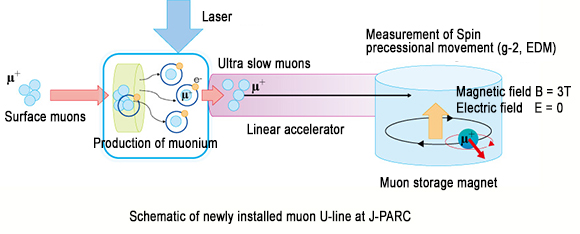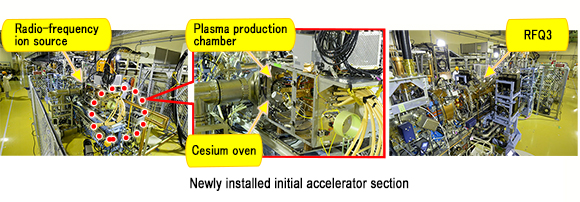| ¡ J-PARC News - September 2014 (Issue #113) |
| BL14 Neutron Instrument at Work in Research on the Function of DNA (Genes) |
|---|
| BL14 "AMATERAS" of the MLF (Materials and Life Science Experimental Facility) is a neutron instrument enabling analysis of phenomena such as the nature of molecular and atomic motion. Recently, Dr. Hiroshi Nakagawa, Assistant Principle Researcher in the Neutron Biophysics Group, Quantum Beam Science Center, Japan Atomic Energy Agency (JAEA) , used this instrument, together with neutron experiments and simulation calculations, to determine that difference in the "ease of bending" of DNA is closely related to the motion of water molecules present in DNA. (Research results were released to the press on 8/29.) |
| Successful Production of Large Amounts of Muonium at Room-Temperature |
|---|
| One of the aims at J-PARC's ultra-slow muon beamline is to produce large amounts of ultra-slow muons. Recently, a joint experiment group, which consists of researchers from KEK, RIKEN and TRIUMF (the Canadian National Laboratory for Particle and Nuclear Physics) , of the Ultra-Slow Muon Beamline Development Project Team successfully developed technology enabling production of large amounts of muonium at room-temperature. The team works for the "Ultra Slow Muon Microscope" project supported by a Grant-in-Aid for Scientific Research on Innovative Areas (Representative: Professor Eiko Torikai, University of Yamanashi) . (Press release 9/18) |
 
 * Click here to enlarge. * Click here to enlarge. |
| |
| £to Page Top |
| |
|
| Accelerator outputs in the design specifications for J-PARC's 3 GeV synchrotron (RCS) and 50 GeV synchrotron (MR) are, respectively, 1 MW and 0.75 MW. In order to achieve those outputs, it was necessary to increase the linac beam energy to 400 MeV and the beam current to 50 mA. During the accelerator shutdown period last year at J-PARC, ACS (Annular-ring Coupled Structure) cavity installation and beam adjustment testing were completed, and in January 2014 400 MeV beam acceleration was successfully achieved. |
| During the shutdown period this summer, the installation work, such as (1) new equipment, (2) the initial accelerator section (ion source and radio frequency quadrupole linac (RFQ) ) and (3) beam chopper cavity, was carried out in order to increase beam current. Performance testing was conducted with a dedicated test stand up to the end of June of this year, and it was confirmed that a beam current of 50 mA could be obtained. |
 
 * Click here to enlarge. * Click here to enlarge. |
| |
| £to Page Top |
| |
| Experimental Facilities |
|---|
| ► Materials and Life Science Experimental Facility (MLF) |
| ▪ Development of High-Density Multiwire Proportional Neutron Counter (MWPC) |
| At the neutron instrument BL17 "SHARAKU" of MLF a new multiwire proportional neutron counter (MWPC) , which was developed at J-PARC, is used to measure dispersed neutrons by a sample. Compared to the previous detector, this new detector more accurately measures neutrons with a higher detection sensitivity, and thereby enables gathering of high-resolution data. In addition, this counter system is the first in the world to use low-noise signal transmission. As a result, it enables to satisfy strict performance requirements for surface and interface science applications. Use for user experiments began in June of this year. |
| ▪ New Type of Muon Production Target |
|---|
| At the MLF, graphite is used as the material of the muon production target. To achieve longer target life in future 1 MW operation-by dispersing radiation damage to graphite material due to the high-intensity proton beam-the previous fixed target was replaced with a rotating target via remote operation. |
| This change is expected to remarkably extend the graphite material life from about 1 year to about 30 years. However, the life of the rotating target is determined by the strength (durability) of the bearing, and thus in the Muon Group, a new target was developed with the aim of achieving a life of 10 years for the new rotating target. In strength and endurance testing of the bearing, there were confirmed to be no problems with durability. |
| ► Neutrino Experimental Facility |
|---|
| At the neutrino primary beamline, normal-conducting electromagnets are used to guide the proton beam ejected from the 50 GeV synchrotron (MR) to the target. A power supply system used by KEK prior to the construction of J-PARC was reused as the power source for these electromagnets, and thus there has been deterioration over time. Effects on performance were evident, thought to be due to the major earthquake in March 2011, and as a result the system was recently replaced with a new power supply in preparation for the resuming operation at the end of October. |
|
| Held Science Cafe "Unveiling the Mysteries of Universe with Proton Accelerators" at Tamarokuto Science Center |
|---|
| A Science Cafe was held on September 20, jointly organized by KEK and the Tamarokuto Science Center in Nishitokyo, Tokyo. The instructor was Dr. Masaru Tada of the J-PARC Neutrino Section who is engaged in research on neutrino particles. |
| About 100 people participated in the lecture, ranging from students in the higher grades of elementary school to senior citizens. Participation greatly exceeded the original target of 60 people. Dr. Tada used creative techniques throughout his presentation, explaining elementary particles in an easy-to-understand way by passing out specially-ordered "Proton Chocolates" to the participants, and comparing the nuts to quarks and the chocolate to energy. He explained everything from accelerator principles to the accelerating expansion of the universe in a very appealing way. |
| After the presentation, there were a number of questions from the audience, and the event finished as a great success. |
|
| International Technical Safety Forum (ITSF) 2014 |
|---|
| ITSF 2014 was held on September 8-12 at the Fermi National Accelerator Laboratory (U.S.), with the participation of the world's major research institutions involved with large accelerators. Representing J-PARC, Dr. Tetsuro Ishii, Head of the Safety Division participated in this forum for the first time. He reported on the radioactive material leak accident at the Hadron Experimental Facility in May of last year, and the restructuring of J-PARC's safety management system. Each year at this forum, participants describe problems that have occurred at their facilities, and taking those problems as lessons to be learned, discuss topics such as accelerator and facility safety management. This is a valuable international conference where information can be exchanged regarding accelerator safety management. |
| FY2014 Voluntary Disaster Preparedness Drills at the Nuclear Science Research Institute |
|---|
| On September 5, drills were carried out at J-PARC, in coordination with voluntary disaster preparedness drills held at the Nuclear Science Research Institute. There are 674 participants including both staff and users. The drills assumed a scenario where a major earthquake had occurred, followed by issuance of a major tsunami warning. The participants evacuated to the designated assembly areas, and various tasks were carried out such as ascertaining the situation of personnel in each department, and reporting to the J-PARC Safety Headquarters and then to the Safety Response Headquarters of the Nuclear Science Research Institute. |
| Safety Patrol by Occupational Safety Consultant |
|---|
| To ensure thorough safety of the work environment at J-PARC, we invite a specialist of workplace safety and conduct safety inspection of J-PARC facilities. The inspections on the Materials and Life Science Experimental Facility (MLF) and Neutrino Experimental Facility have been already conducted. On September 22, a meeting was held to report the results to persons involved with these facilities. This was an excellent opportunity to hear valuable pointers and advice. There was a great response within the center, and we had many participants including persons from other facilities. At the meeting, the consultant discussed topics such as specific clean-up techniques in response to a question about being neat and orderly. |
|
©2014 J-PARC Center. All rights reserved.
|
|